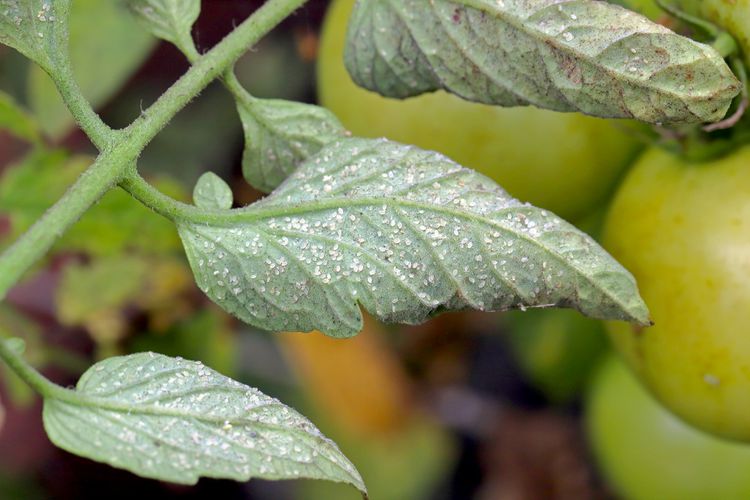Spotting tiny white bugs on plants in your garden or home can be distressing. What are they? Will they hurt your plant? What should you do?
A few different small white insects commonly feed on a wide variety of plants, so you're likely encountering one of them. While a few insects on a plant are often no cause for concern, their numbers can quickly build up. This guide will help you identify tiny white bugs on plants indoors and out in the garden, plus provide tips for getting rid of them.
1. Whiteflies
Whiteflies can be problematic on lots of different ornamental plants, houseplants, and common garden crops like tomatoes, peppers, sweet potatoes, cucumbers, the cabbage family, and okra.
What They Look Like
Whiteflies are not actually flies, but they are soft-bodied tiny white bugs that can fly. With their wings folded, they appear slightly triangular. Whiteflies are active during the day and fly around when disturbed—a big clue to help you identify them. If you find little white flying bugs that flutter off en masse when you move the plant, they’re likely whiteflies.
Symptoms
Whiteflies feed with piercing-sucking mouthparts like aphids. Damage from a whitefly feeding looks like pale spots or yellowing leaves, which may eventually wither and fall off the plant. Stunted growth and damage to newly unfurled leaves are common. The presence of honeydew, a sticky substance, is another good indicator.
Controls
Start with a good blast from the hose to get rid of whiteflies. Although whiteflies can fly as adults, the newly hatched nymphs cannot and can be washed off, along with some eggs. Even the adults can be injured or dispersed. Use yellow sticky card traps to monitor for the pests, as their numbers can build up quickly and go unnoticed until they mature. Insecticidal soap sprayed on the undersides of leaves is moderately effective, but use caution to avoid affecting pollinators.
2. Aphids
Aphids are a large group of insects, and many are specific in their target plants. For example, potato aphids feed on potatoes, tomatoes, eggplants, peppers, and other members of the Solanaceae family. Cabbage aphids feed on cruciferous family members, like cabbages and greens. However, with such a large group, almost any plant can be attacked, from houseplants to outdoor ornamentals.
What They Look Like
Another small, often white bug, aphids are usually less than a quarter inch long and frequently much smaller. Many adults are wingless. Look with a magnifying glass to spot two long antennae and two tubes projecting from the rear. Aphids often hide on the underside of leaves.
Symptoms
Look for curling, fading, stippled patterns, and yellowing leaves. Honeydew, the sticky substance left after aphids feed, and the black mold that grows on it are other telltale signs. Stunted growth and dead shoots are indicators.
Controls
Aphids are not usually bothersome enough to worry about, as they seldom do enough damage to be worth the effort. However, if they build up to high levels, aphids can be effectively knocked off plants by a strong stream from the garden hose and usually won’t crawl back up.
Encourage beneficial predatory insects like lacewings, lady beetles, and predatory wasps by planting native flowers nearby and creating a habitat where something is blooming all season long.
3. Mealybugs
Any soft-tissue houseplant is fair game for mealybugs. Closely inspect any newly acquired plant and quarantine it for a week or 10 days while watching for these small white bugs on plant stems and leaves. The most common way mealybugs become a problem on indoor plants is to hitchhike in on a newly purchased plant.
What They Look Like
Mealybugs are pale pink but covered in a soft, white, waxy material, and they’re small, often only 1/16 of an inch. The citrus mealybug is the most commonly found species on houseplants. An egg mass of the citrus mealybug looks like a small, white, cottony mass on the underside of a leaf.
Symptoms
Damage from mealybugs feeding on plants looks like a general decline of the plant, with yellowing, dropping leaves, and stunted growth.
Controls
A visual inspection looking for white cottony spots is the best way to find these pests. Check new growth tips, stem crotches, and leaf folds. Mealybugs can be controlled by washing them off in the sink or wiping the insects off with a cotton swab. You may need to do this several times over a few days. Insecticidal soap can be effective if applied to those hard-to-reach areas where the bugs hide.
4. Thrips
With so many species, thrips can target many shrubs, ornamental flowers, and vegetables. Houseplants and young seedling starts are also susceptible.
What They Look Like
Thrips are a large group of insects, many appearing as translucent white or pale yellow, especially in the larval stage. Thrips are small, often only 1/16 inch long. They can be hard to see, so shake the foliage of a potentially infected plant over a sheet of white paper. Yellow sticky traps are also effective for monitoring their presence.
Symptoms
Thrip damage often begins as tiny pale spots on the leaves called stippling. The leaves may become pale and paper-like. New terminal shoots can roll up and be discolored. Thrips don’t often kill the plant; they are more of a nuisance. Young plants are especially susceptible to stunted growth. Tiny black dots (excrement from feeding thrips) are another indicator.
Controls
A good blast with the garden hose is an excellent start to controlling thrips on a shrub or in the garden. Floating row covers can be used to protect garden crops from infestation, starting when the plants are young and removing them when they grow larger. Beneficial predatory insects can be of great help. A diverse planting of native species can encourage lacewings, lady beetles, and predatory wasps to hang around and keep thrips in check.




















